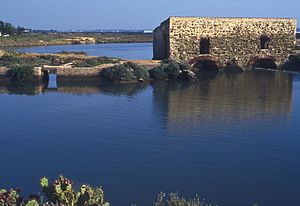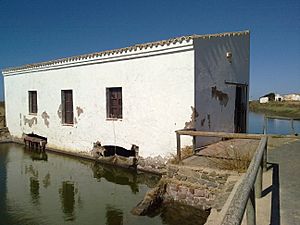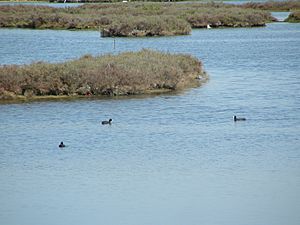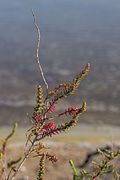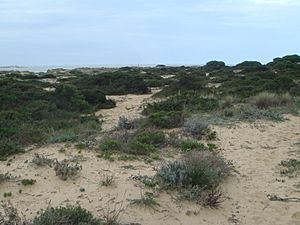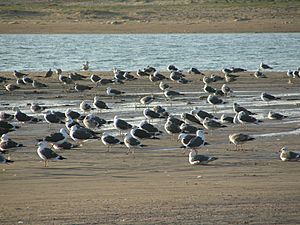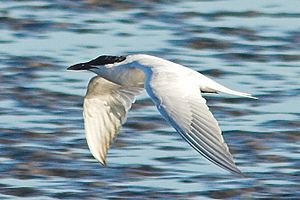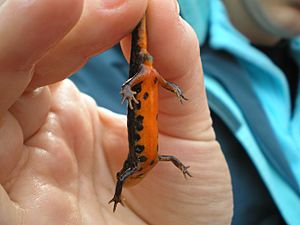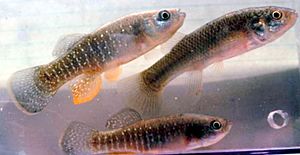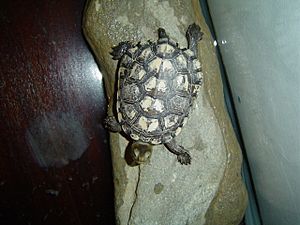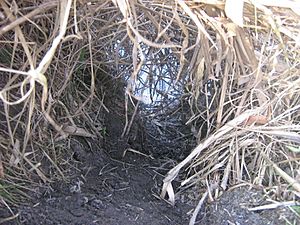Marismas de Isla Cristina facts for kids
Quick facts for kids Marismas de Isla Cristina |
|
|---|---|
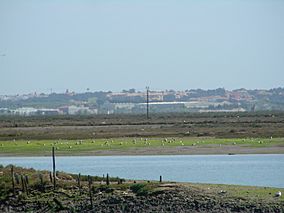 |
|
| Area | 21.45 km2 (8.28 sq mi) |
| Designation | Site of Special Scientific Interest |
| Authorized | September 23, 1989 |
| Website | Natural England website |
The Marismas de Isla Cristina (which means "Cristina Island marshes") is a special natural park in southern Spain. It's located where the Carreras river meets the sea, in the province of Huelva, Andalusia. This natural park was created in 1989 to protect its unique environment.
It covers an area of about 21.45 square kilometers (about 8.28 square miles). This land is shared between two towns: Ayamonte and Isla Cristina.
Contents
What are the Marismas de Isla Cristina?
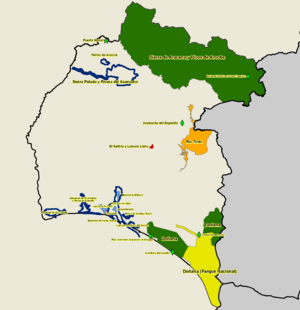
Marshes are wet, low-lying areas that get flooded by seawater during high tide. The Marismas de Isla Cristina are a great example of this, located in a river mouth. Because they depend on the tides, these marshes don't change much with the seasons.
You can see two main types of areas here. Some parts of the marsh have been changed by people for things like farming or raising fish. Other parts are still wild and natural.
Even where people have changed the marsh, like for fish farms, the original water channels and streams are still there. In the wilder areas, you'll find special plants that can live in salty water. These plants are called halophytes, and they are used to being flooded by the tides every day.
The animals here are also very important, especially the birds. The marsh's flat landscape offers wide views, letting you see the city of Isla Cristina and nearby pine forests. The colors of the marsh change throughout the day as the light shifts, making it a beautiful place to visit.
Different Parts of the Marsh
The Marismas de Isla Cristina is made up of several unique sections. Each part has its own special features.
Carrera Marsh
This part of the marsh is about 2.66 square kilometers. It's a protected area where you'll find lots of needlegrass (also known as esparto) and other salt-loving plants. In areas that don't flood as much, you might see broom bushes and reeds. This area is very flat and acts as a natural bridge between the land and the sea. It's home to many water birds, which makes it very special.
Meadow Marsh (Marisma del Prado)
This smaller section, about 0.3 square kilometers, was once used for growing strawberries. It's very similar to the Carrera marsh. A path starts from the nearby town of Redondela, leading into this part of the marsh.
Puntal Canal Marsh
This area covers about 3.71 square kilometers. It's located between Isla Cristina and Ayamonte. In the past, this part of the marsh was used to make salt. Today, it's used for raising fish and shellfish (aquaculture). These activities have changed the marsh, making it less diverse.
Here, you can find a well-preserved tidal mill. This mill, called Molino de El Pintado, was restored in 1995. Now, it serves as a small visitor center where you can learn about the marsh.
Transformed Carreras Marsh
This section is about 0.76 square kilometers. Like the Puntal Canal marsh, it has been changed by human activities. People use it for aquaculture (fish farming) and growing strawberries. These uses have created ponds and pools, but they also affect the natural marsh environment.
The Moral
This large area, about 3.11 square kilometers, has grasslands that are influenced by the tides. People have planted tamarisk trees here. You can also find well-preserved salt marshes with plants like salicornia and eel grass.
The Slumps' Saltworks (Salinas de los Pérez)
This tidal marsh, about 1.66 square kilometers, has special plants like Arthrocaulon macrostachyum. It's also home to rare and protected plant species. This area has been transformed into saltworks, where salt is collected from the sea.
The Tamijar
This is one of the main parts of the nature reserve, covering about 5.89 square kilometers. It has important groups of salt-loving plants. Like other areas, it also has saltworks. The Via Verde Litoral road crosses its northern part. Many wading birds, gulls, and herons live here.
Robalito Point
This section includes the Canela and Pinillo lagoons. It's about 2.37 square kilometers and has areas of saltworks near Ayamonte. Unfortunately, some parts of this area have been affected by city development.
Salón de Santa Gadea
This area connects directly to Ayamonte and is about 0.97 square kilometers. More than half of it is salty. You'll find lots of almajos and needlegrass here.
Geography of the Marshes
The way the water flows in the marshes today has been shaped by history. A big earthquake in Lisbon in 1755 changed the land. Also, the movement of sand and dirt, and the influence of the Guadiana and Tinto-Odiel rivers, have played a role. Human-made structures like dikes also change how water and sediments move.
The marshes surround the mouth of the Carreras river. Dikes on both sides of Isla Cristina port town help control the water flow. The area has many small rivers and canals that flow into the main river. To the west, the marshes are next to Ayamonte and a nature reserve in Portugal. To the north is the Vía Verde Litoral road. To the south are Isla Cristina city and the Atlantic Ocean.
Most of the water in the marshes comes from the Atlantic Ocean. The Guadiana river also brings in sediments, which helps keep the marsh canals healthy. Because of this, some parts of the marsh are saltier than others. Some areas are even used to collect salt for commercial use.
This area is a great example of how the coast changes over time. The wind, waves, tides, rivers, and human structures all work together to create this unique landscape at the mouth of the Guadiana river.
Visiting the Nature Park
The Marismas de Isla Cristina is a wonderful place to explore nature. You can find special spots for birdwatching in several places, especially along the Via Verde. This Via Verde is an old railway line that has been turned into a path. It's perfect for hiking and cycling because it's mostly flat.
There are also other hiking trails with information points. You can find these at Prado Pond, the Molino tidal marsh of Pozo del Camino, and the Duque saltworks.
There are three marked paths in the marshes for visitors:
- Laguna del Prado: This path is about 1.19 kilometers (1,300 yards) long. You can reach it easily from the village of La Redondela.
- Tidal Mill of the Pozo Path: This path is about 835 meters (913 yards) long. You can get to it directly from the Via Verde road near Pozo del Camino.
- The Duke Saltworks: This path is about 7.15 kilometers (4.44 miles) long and takes about 2 hours to walk. It's a great spot for bird watching and can be accessed from the north of Punta del Morral.
Ecomuseum
The ecomuseum of the Cristina Island marshes is located at the tidal mill of the Pozo path. It has an Interpretation Center where you can learn about the relationship between people and the marsh. This tidal mill was built in the 18th century and has been restored.
At the museum, you can discover how people have used the marshes over time. The mill, also known as the Painted's Mill, had six grinding stones. It was built by Manuel Rivero, a local person from Ayamonte. The museum opened in October 2009. It helps visitors understand this important wetland ecosystem.
Biology of the Marshes
The Marismas de Isla Cristina is a very important place for wildlife. Many protected species use it as a home during winter, for breeding, or for nesting. This means it's crucial to protect and preserve this area. Information panels around the reserve help visitors understand how the marsh works and why its protection is so important.
These panels often highlight the many water birds that live here. The marsh is recognized as a "Site of Community Importance" (LIC) and a "Special Protection Area for Birds" (ZEPA). This shows how valuable it is for bird conservation.
One important mammal found here is the otter (Lutra lutra). Otters are a protected species in Europe, and special areas are created to help them survive. Besides otters, the marsh is home to 22 bird species that are specially protected. It also hosts 41 types of migratory birds that visit regularly.
Flora: Plants of the Marsh
The plants in the Marismas de Isla Cristina have to be tough! They need to be able to live in salty conditions, so there aren't as many different types of plants as there are animals. The most common plants you'll find here include:
- Stone pine (Pinus pinea)
- Phoenicean juniper (Juniperus phoenicea)
- Topped lavender (Lavandula stoechas)
- Rosemary (Rosmarinus officinalis)
- Shrubby sea-blite (Suaeda vera)
- Picris (Picris wilkommi)
You might also see the maritime juniper (Juniperus oxycedrus subsp. macrocarpa). This special shrub only grows in certain parts of Andalusia, like Huelva and Cadiz. Remember, it's not allowed to pick any plants in this natural park.
Fauna: Animals of the Marsh

The Marismas de Isla Cristina is full of amazing animals!
Birds of the Marsh
The most common and important birds you'll see here are spatulas, storks, and terns. Some birds live in the marsh all year round, while others only visit during winter or summer. If you want to know more about the specific bird species, you can check the bird appendix (Anexo:Aves de las Marismas de Isla Cristina).
Amphibians of the Marsh
The marsh is home to various amphibians, including salamanders, frogs, and toads. Some of them are:
- Iberian midwife toad (Alytes cisternasii)
- Common toad (Bufo bufo)
- Natterjack toad (Epidalea calamita)
- Mediterranean tree frog (Hyla meridionalis)
- Fire salamander (Salamandra salamandra)
- Iberian ribbed newt (Pleurodeles waltl)
- Bosca's newt (Triturus boscai)
Fish of the Marsh
Many fish live in the marshes, and they are an important food source for the birds. Some of the fish you might find include:
- Sea lamprey (Petromyzon marinus)
- Allis shad (Alosa alosa)
- Iberian barbel (Barbus comizo)
- Mummichog (Fundulus heteroclitus)
Reptiles of the Marsh
There is one main reptile species here: the Spanish pond turtle (Mauremys leprosa). They are not seen very often because they are not very active.
Mammals of the Marsh
The only native mammal that truly belongs to this marsh ecosystem is the otter (Lutra lutra). While other animals like rats or mice might be present, they are not considered part of the core marsh wildlife.
Images for kids
See also
 In Spanish: Marismas de Isla Cristina para niños
In Spanish: Marismas de Isla Cristina para niños
- Natural park (Spain)



